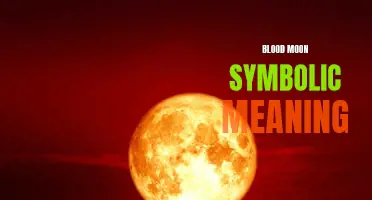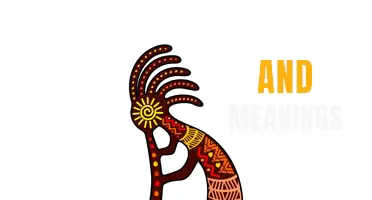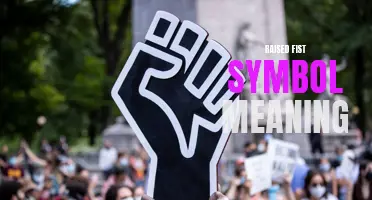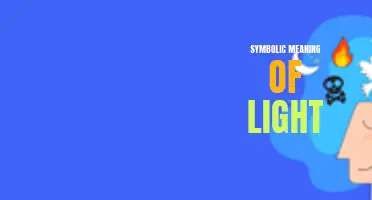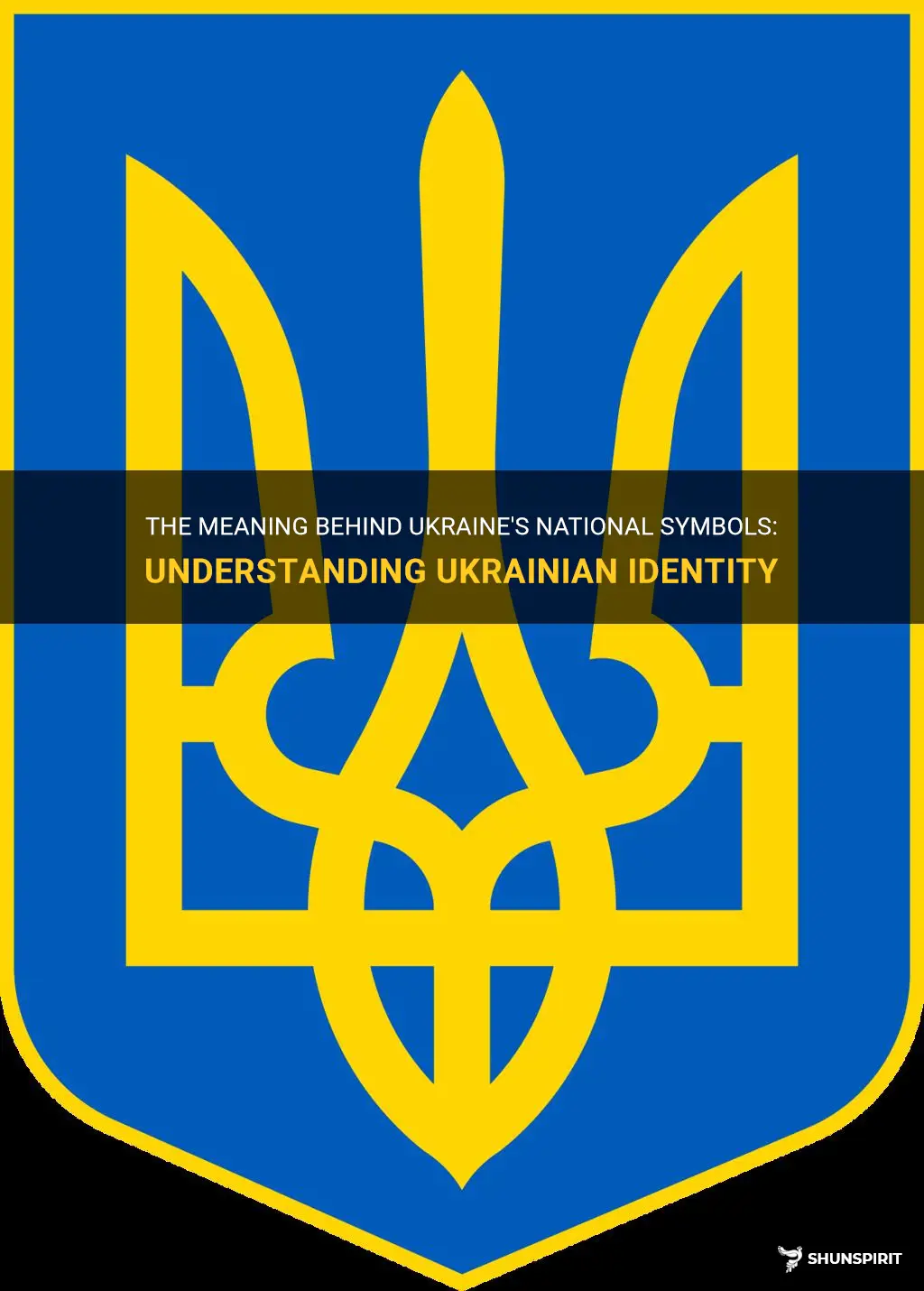
Ukraine, a beautiful country in Eastern Europe, brims with rich cultural symbols that reflect its history, traditions, and national identity. These symbols have deep and profound meanings, representing the resilience, strength, and beauty of the Ukrainian people. From the majestic trident, known as the Tryzub, to the vibrant and intricate embroidery patterns found on traditional clothing, each symbol tells a unique story and holds a special place in the country's heritage. In this article, we will explore the fascinating world of Ukrainian symbols and uncover the hidden meanings behind them, giving you a glimpse into the soul of Ukraine.
What You'll Learn
- What is the significance of the Ukrainian flag's colors and design?
- What is the meaning behind the Ukrainian coat of arms and its symbols?
- Why is the trident (tryzub) such an important symbol in Ukrainian culture and history?
- Are there any other significant symbols or icons that represent Ukraine and its culture?
- How has the meaning of Ukraine's symbols evolved over time, particularly during different political eras?

What is the significance of the Ukrainian flag's colors and design?
The Ukrainian flag is a national symbol of Ukraine and holds significant meaning for the country and its people. The flag consists of two horizontal bands of equal width, with the top band being blue and the bottom band being yellow. The blue color represents the sky and symbolizes peace, while the yellow color represents the country's golden wheat fields and symbolizes prosperity.
The design of the Ukrainian flag holds historical significance as well. It is believed that the blue and yellow colors were first used by the Grand Duchy of Lithuania, which ruled over a large portion of what is now modern-day Ukraine. These colors later became associated with the Ukrainian Cossacks, who fought for independence and freedom in the 17th century.
During the struggle for Ukrainian independence in the 19th and 20th centuries, the blue and yellow flag became a symbol of national identity and unity. It was used by various Ukrainian political organizations and was officially adopted as the national flag of Ukraine in 1918.
The colors and design of the Ukrainian flag also have deeper cultural and historical meanings. Blue has long been associated with the Slavic people and is often seen as a symbol of spirituality, truth, and freedom. Yellow, on the other hand, represents strength, optimism, and the fertile lands of Ukraine.
Today, the Ukrainian flag is widely recognized as a symbol of the country's independence and sovereignty. It is prominently displayed on public buildings, schools, and during national holidays and events. It is also a common sight at sports competitions, where Ukrainian athletes proudly wear the flag on their uniforms.
The blue and yellow colors of the Ukrainian flag have also been incorporated into various national symbols, such as the coat of arms and the national emblem. Additionally, the flag has inspired many Ukrainian artists, writers, and musicians, who use its colors and imagery to express their love for their country and its rich culture.
In conclusion, the Ukrainian flag holds significant meaning for the country and its people. The blue and yellow colors represent peace, prosperity, and national identity. The flag's design has historical roots dating back centuries and has become a powerful symbol of Ukrainian independence and unity. Whether it is displayed in public or used in artistic expressions, the flag is an important symbol that represents the spirit and aspirations of the Ukrainian people.
The Symbolic Meanings of Sanskrit Symbols: Unlocking the Ancient Wisdom
You may want to see also

What is the meaning behind the Ukrainian coat of arms and its symbols?
The Ukrainian coat of arms, also known as the small coat of arms or lesser coat of arms, is a national symbol of Ukraine. It is a representation of the country's history, culture, and values. The coat of arms consists of several key symbols that have deep and significant meanings.
At the center of the coat of arms is a blue shield, which represents the sky and the importance of faith and spirituality in Ukrainian society. The shield is divided into two equal parts by a golden trident, which is one of the most recognizable symbols of Ukraine.
The trident, or tryzub, is a symbol that dates back to ancient times and has been used in various forms throughout Ukrainian history. It is a symbol of strength, independence, and unity. The three points of the trident represent the three core values of Ukrainian society: freedom, independence, and unity.
Above the shield, there is a crown, symbolizing the sovereignty and independence of Ukraine. The crown consists of a ring of golden spikes topped with a regal cross, symbolizing the spiritual roots of the nation.
On either side of the shield, there are golden-wrapped ears of wheat, which represent fertility, prosperity, and abundance. Wheat has been a staple crop in Ukraine for centuries, and it symbolizes the importance of agriculture and the land in Ukrainian culture.
The coat of arms is surrounded by eight-pointed stars, which represent the eight historical regions of Ukraine. These stars also symbolize the importance of territorial integrity and unity within the country.
Overall, the Ukrainian coat of arms is a powerful symbol that encapsulates the history, culture, and values of the Ukrainian people. It represents their strength, independence, unity, spirituality, and prosperity. It serves as a proud and unifying national emblem that reminds Ukrainians of their past and inspires them for the future.
The Rich Symbolism and Fascinating Meanings Behind Mesopotamian Symbols
You may want to see also

Why is the trident (tryzub) such an important symbol in Ukrainian culture and history?
The trident, known as the "tryzub" in Ukrainian, is one of the most important symbols in Ukrainian culture and history. It has deep roots in the country's past and continues to hold significant meaning for Ukrainians today.
Historically, the trident has been associated with Ukraine since ancient times. The symbol itself consists of three pointed blades or spears, arranged in such a way that they form a unified whole. This design is believed to represent the unity of three important elements: the land, the people, and the spirit of Ukraine.
One of the earliest depictions of the trident can be found on ancient artifacts dating back to the 12th century. It was during this time that the symbol became associated with the ruling dynasty of the Kyivan Rus, a medieval state that encompassed parts of present-day Ukraine, Russia, and Belarus. The trident became a symbol of power and authority, representing the sovereignty and independence of the Ukrainian people.
Throughout history, the trident continued to be used as a symbol of Ukrainian identity and resistance against foreign oppression. During the 19th and 20th centuries, when Ukraine was under the rule of the Russian and Soviet empires, the trident became a powerful emblem of national pride and defiance. Ukrainians saw the trident as a way to assert their unique cultural heritage and fight for independence.
The trident gained even more significance during the 20th century, particularly during Ukraine's struggle for independence in the early 1990s. After the collapse of the Soviet Union, Ukraine adopted the trident as its official coat of arms, symbolizing the country's sovereignty and aspirations for a free and independent future.
Today, the trident remains a symbol of Ukrainian national identity and unity. It is prominently displayed on the national flag, official documents, and government institutions. The trident can be seen as a rallying point for Ukrainians, reminding them of their shared history, culture, and aspirations.
In addition to its historical and cultural importance, the trident also holds symbolic meaning for Ukrainians on a personal level. The symbol is often associated with concepts such as freedom, independence, and strength. It serves as a reminder of the resilience and determination of the Ukrainian people in the face of adversity.
Overall, the trident (tryzub) is a symbol deeply rooted in Ukrainian culture and history. It represents the unity, independence, and strength of the Ukrainian people. It serves as a reminder of past struggles and a symbol of hope for a prosperous and free future.
The Vital Guide to Understanding Forklift Warning Light Symbols and Their Meanings
You may want to see also

Are there any other significant symbols or icons that represent Ukraine and its culture?
Ukraine is a country rich in culture and history, and there are many symbols and icons that represent its unique heritage. While the flag and coat of arms are the most recognizable symbols, there are several other significant symbols and icons that play an important role in Ukrainian culture.
One of the most prominent symbols in Ukrainian culture is the trident, known in Ukrainian as "Tryzub." The trident is a stylized depiction of a three-pronged spear or pitchfork, and it has been used in Ukrainian heraldry for centuries. The trident is often associated with the country's historical and cultural heritage and represents strength, unity, and independence. It is also present on the coat of arms of Ukraine, making it an important national symbol.
Another iconic symbol of Ukraine is the wheat sheaf, or "Snop." The wheat sheaf represents the country's agricultural traditions and its status as the breadbasket of Europe. Wheat has long been a staple crop in Ukraine, and the wheat sheaf symbolizes prosperity, abundance, and fertility. This symbol can be seen in various forms of artwork, embroidery, and traditional Ukrainian costumes.
Embroidery, known as "Vyshyvka," is an integral part of Ukrainian culture and is often seen as a symbol of national identity. Traditional Ukrainian embroidery features intricate designs and patterns, often depicting flowers, birds, and geometric shapes. Each region of Ukraine has its own unique embroidery styles and motifs, making it a significant representation of regional diversity and cultural heritage.
The pysanka, or Ukrainian Easter egg, is another iconic symbol of Ukrainian culture. Pysanky are beautifully decorated using a wax-resist method, and each design carries its own special meaning. The intricate patterns and vibrant colors of pysanky symbolize renewal, rebirth, and the beginning of spring. Pysanky are not only a cherished tradition in Ukraine but have also gained popularity worldwide for their artistic beauty.
Traditional Ukrainian musical instruments also play a significant role in Ukrainian culture. The bandura, a string instrument similar to a lute, is considered the national instrument of Ukraine. It has a rich history dating back many centuries and is often associated with the legendary Ukrainian Cossacks. The trembita, a long wooden horn, is another iconic instrument that represents Ukrainian mountain and shepherd culture. Both instruments are widely used in traditional folk music and are symbols of national pride and heritage.
In conclusion, while the flag and coat of arms are the most recognizable symbols of Ukraine, there are many other significant icons that represent the country and its culture. The trident, wheat sheaf, embroidery, pysanky, and traditional musical instruments all play an important role in preserving and showcasing Ukraine's unique heritage. These symbols are not only cherished by Ukrainians but also serve as a source of national pride and identity.
The Symbolic Meaning of Grasshoppers: What Do They Represent?
You may want to see also

How has the meaning of Ukraine's symbols evolved over time, particularly during different political eras?
Symbols play a crucial role in shaping a nation's identity and uniting its people. They serve as visual representations of values, aspirations, and history. In Ukraine, the meaning of symbols has evolved over time, especially during different political eras. From ancient times to the present day, Ukraine's symbols have undergone significant changes that reflect the country's historical and political transformations.
One of the most enduring symbols in Ukraine is the trident, known as Tryzub. This symbol dates back to Kyivan Rus and represents the country's ancient heritage. Originally, the trident was associated with the ruling dynasty and symbolized the power of the prince. Over time, it became a symbol of national identity and Ukraine's struggle for independence.
During the Soviet era, Ukraine's symbols were suppressed and replaced with those promoting Soviet ideology. The trident was banned, and instead, the hammer and sickle, as well as the red star, represented the Soviet Union's power. These symbols sought to create a sense of unity and loyalty to the Soviet state, erasing any nationalistic sentiments.
However, with the collapse of the Soviet Union in 1991, Ukraine regained its independence and began a process of national reawakening. The trident resurfaced as a symbol of Ukraine's sovereignty and national pride. It was prominently displayed on the newly adopted state coat of arms and flag, representing the country's commitment to democratic values and independence.
Since gaining independence, Ukraine has faced numerous political challenges that have influenced the meaning of its symbols. The Orange Revolution of 2004, which aimed to overturn a controversial presidential election, saw the color orange become a symbol of unity and resistance against fraudulent practices. The orange ribbon became a popular emblem of support for the opposition movement.
Similarly, during the Euromaidan protests in 2013-2014, Ukrainians took to the streets to demand closer ties with Europe and an end to corruption. The Ukrainian flag, with its blue and yellow colors, became a powerful symbol of these aspirations. People waved flags and wore ribbons in patriotic colors to demonstrate their commitment to a European future and their pride in being Ukrainian.
In recent years, another symbol of Ukraine's struggle against Russian aggression has emerged – the Ukrainian coat of arms with a crossed-out Soviet star in the middle. This alteration of the national emblem reflects the ongoing conflict with Russia and signifies Ukraine's rejection of its Soviet past and desire to establish a new, independent identity.
In conclusion, the meaning of Ukraine's symbols has evolved over time, reflecting the country's shifting political landscape. From ancient times to the present day, these symbols have represented national identity, resistance against oppression, and aspirations for independence and democracy. The trident, the colors of the flag, and other symbols have become powerful visual representations of Ukraine's rich history and its determination to shape its own future.
Unlocking the Hidden Meanings Behind the NEDA Symbol Tattoo
You may want to see also
Frequently asked questions
The symbol on the flag of Ukraine is called the trident. It is a stylized depiction of a golden falcon with its wings spread. The trident has been a symbol of Ukraine for centuries and represents the country's historic connection to the ruling dynasty of Kyivan Rus.
The trident on the Ukrainian flag does not have specific religious significance. However, it is worth noting that the trident symbol has been used by various Slavic pagan and Christian cultures throughout history. In the context of Ukraine, the trident on the flag represents the country's cultural heritage and independence.
Yes, the trident symbol is closely tied to the national identity of Ukraine. It is seen as a symbol of strength, independence, and national pride. The trident has been used in various forms as a symbol of Ukrainian identity dating back to the medieval period. Today, it continues to be an important symbol of Ukraine's sovereignty and heritage.


